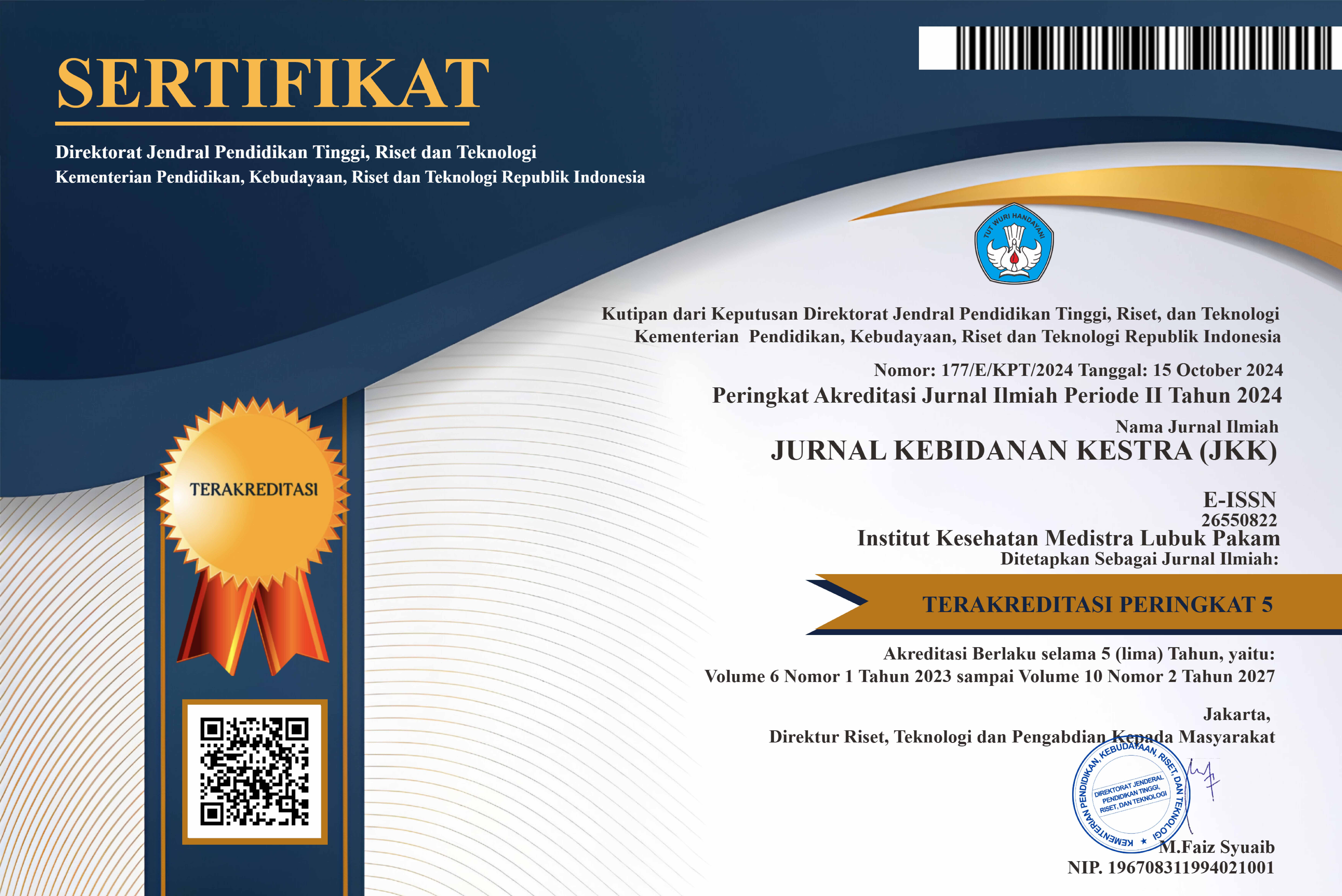HUBUNGAN ADIPONEKTIN ASI DENGAN BERAT BADAN BAYI USIA 1-3 BULAN
DOI:
https://doi.org/10.35451/jkk.v1i1.95Keywords:
Adiponectin, Breast Milk, Baby WeightAbstract
Adiponectin is a hormone that plays a role in the body’s metabolic system. Adiponectin is found in breast milk and has an important role on the growth of babies and are associated with baby weight gain. The aim of this study was to fine the relationship between adiponection level of breast milk and the weight of 1-3 month old babies. The study was designed to be analytic cross-sectional observational upon 32 pospartum mothers who breastfeed exclusively in the working territory of Andalas, Alai, and Ambacang Community Health Center, Padang from March until November 2015. The sample was selected by consecutive sampling. Examination of adiponectin level in breast milk was conducted in Biomedical Laboratory of Faculty of Medicine of Andalas University by using ELISA method. Data normality was tested by Saphiro-Wilk, paired t test for mean difference and Pearson correlation test to assess the the correlation between adiponectin level in breast milk and baby weight by using SPSS version 16.0. The mean of adiponectin level in breast milk at 1 and 3 months postpartum was 33,32±13,50 ng/mL and 39,88±13,48 ng/mL (p<0,05). There was significant negative correlation between adiponectin level in breast milk and the weight of 0-1 month old babies(r=-0,437; p<0,05). There was weak negative correlation between adiponectin level in breast milk and the weight of 1 and 3 month old babies(r=-0,228 ; p>0,05) and (r=-0,177 ; p>0,05). In conclusion, adiponectin level in breast milk in the first month postpartum is lower than that in the third month postpartum. Adiponectin level in breast milk was negatively correlated with the increase of baby weight gain.
Downloads
References
Ballard, O. and Morrow, A. L. (2013) ‘Human Milk Composition. Nutrients and Bioactive Factors’, Pediatric Clinics of North America. Elsevier Inc, 60(1), pp. 49–74. doi: 10.1016/j.pcl.2012.10.002.
BBC (2014a) ‘No Title’, BBC INDONESIA. Available at: https://www.bbc.com/indonesia/majalah/2014/05/140529_iptek_indonesia_obesitas.
BBC (2014b) Tingkat obesitas Indonesia nomor 10 dunia, BBC INDONESIA. Available at: https://www.bbc.com/indonesia/majalah/2014/05/140529_iptek_indonesia_obesitas (Accessed: 18 September 2014).
Bozzola, E. et al. (2010) ‘Role of adiponectin and leptin on body development in infants during the first year of life’, Ital J Pediatr, 36, p. 26. doi: 1824-7288-36-26 [pii]\r10.1186/1824-7288-36-26.
Bronsky, J. et al. (2011) ‘Adiponectin, AFABP, and leptin in human breast milk during 12 months of lactation’, Journal of Pediatric Gastroenterology and Nutrition, 52(4), pp. 474–477. doi: 10.1097/MPG.0b013e3182062fcc.
Bronský, J. et al. (2012) ‘Immunoexpression of type-1 adiponectin receptor in the human intestine’, Ceskoslovenska patologie, 48(3), p. 165—166. Available at: http://europepmc.org/abstract/MED/23057433.
Conita, D. A. (2014) The Growth Differences of Infants aged 3-6 months who were exclusively breastfed and who were not exclusively breastfed, Universitas Tanjung Pura.
Foxcroft1, K. F. et al. (2011) ‘Exercise in obese pregnant women: The role of social factors, lifestyle and pregnancy symptoms’, BMC Pregnancy and Childbirth. BioMed Central Ltd, 11(1), p. 4. doi: 10.1186/1471-2393-11-4.
Fukuda, S., Takeshita, T. and Marimoto, K. (2001) ‘Obesity and Lifestyle’, Asian Medical Journal, 44(3), pp. 97–102.
Inami, I. et al. (2007) ‘Impact of Serum Adiponectin Concentration on Birth Size and Early Postnatal Growth’, Pediatric Research, 61(5), pp. 604–606. doi: 10.1203/pdr.0b013e3180459f8a.
Klamer, A. et al. (2007) ‘Adiponectin levels measured in dried blood spot samples from neonates born small and appropriate for gestational age’, European Journal of Endocrinology, 157(2), pp. 189–194. doi: 10.1530/EJE-06-0710.
Kopelman, P. G. (2000) ‘Physiopathology of prolactin secretion in obesity’, International Journal of Obesity, 24, pp. S104–S108. doi: 10.1038/sj.ijo.0801291.
Mann, D. (2014) Sleep and Weight Gain Will better sleep help you avoid extra pounds?, Web MD. Available at: https://www.webmd.com/sleep-disorders/features/lack-of-sleep-weight-gain#1.
Martin, L. J. et al. (2006) ‘Adiponectin is present in human milk and is associated with maternal factors’, Am J Clin Nutr, 83(5), pp. 1106–1111. doi: 83/5/1106 [pii].
Mousa Numan Ahmad and Lilas Mohammad Fahham (2014) ‘Serum Leptin, Adiponectin and Vaspin Concentrations in Early Infancy: Relation to Feeding Practices and Indices of Growth and Adiposity’, Life Science Journal, 11(10), pp. 89–97.
Available at: http://www.lifesciencesite.com/lsj/life1110/015_26270life111014_89_97.pdf.
Newburg, D. S., Woo, J. G. and Morrow, A. L. (2011) ‘Characteristics and potential functions of human milk adiponectin’, Pediatrics, 156, pp. 1–15. doi: 10.1016/j.jpeds.2009.11.020.Characteristics.
Nilsson, L. et al. (2005) ‘Prolactin and growth hormone regulate adiponectin secretion and receptor expression in adipose tissue’, Biochemical and Biophysical Research Communications, 331(4), pp. 1120–1126. doi: 10.1016/j.bbrc.2005.04.026.
Qi, Y. et al. (2004) ‘Adiponectin acts in the brain to decrease body weight’, Nature Medicine. Nature Publishing Group, 10, p. 524. Available at: http://dx.doi.org/10.1038/nm1029.
Savino, F. et al. (2009) ‘Breast Milk Hormones and Their Protective Effect on Obesity’, International Journal of Pediatric Endocrinology, 2009, pp. 1–8. doi: 10.1155/2009/327505.
Schuster, S. et al. (2011) ‘Leptin in maternal serum and breast milk: Association with Infants’ body weight gain in a longitudinal study over 6 months of lactation’, Pediatric Research, 70(6), pp. 633–637. doi: 10.1203/PDR.0b013e31823214ea.
Shils ME, Olson JA, S. M. et al (1999) Modern Nutrition in Health and Disease. 10th edn. Edited by M. E. SHils et al. Baltimore: Lippincott William & Wilkins.
Syarif, D. . (2003) Childhood Obesity : Evaluation & Management. Surabaya.
Weyermann, M., Rothenbacher, D. and Brenner, H. (2006) ‘Duration of breastfeeding and risk of overweight in childhood : a prospective birth cohort study from Germany’, pp. 1281–1287. doi: 10.1038/sj.ijo.0803260.
WHO (2014) Childhood overweight and obesity, WHO. Available at: http://www.who.int/dietphysicalactivity/childhood/en/ (Accessed: 20 July 2014).
Woo, J. G. et al. (2013) ‘the Second Year of Life’, 54(4), pp. 532–539. doi: 10.1097/MPG.0b013e31823fde04.Human.
Downloads
Published
Issue
Section
License
Copyright in each article is the property of the Author.



























